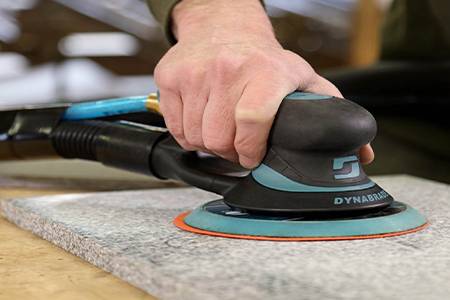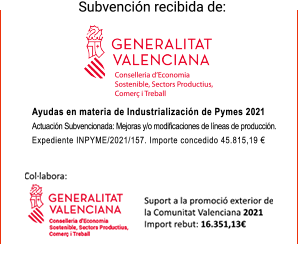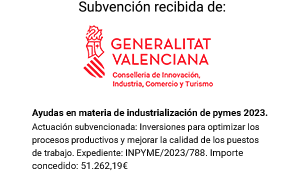¿Necesitas un lijado de precisión sin dañar superficies delicadas? Descubre las ventajas del disco de espuma estándar...
}The abrasive grain is a mineral particle, previously ground, sieved, heat treated and subsequently anchored and fixed to a support. The abrasive grain performs the function of starting, cutting or scratching the surface by mechanical or manual action. It is the part of the abrasive that comes into direct contact with the material to be sanded. It is considered, therefore, a cutting tool with millions of edges.
In this article we will see everything you need to choose the proper numbering of the grain, as well as other important questions about it.
The grain is the part of the abrasive that comes into direct contact with the material to be sanded
Previous issues about abrasives: background
To fully understand the use of different abrasive materials, we must review the chronology of the use of these tools:
Already in prehistory, men had to use sand to clean and sharpen their stone knives. Also to modify the shapes of your utensils.
Archaeologists cite the polishing of weapons and utensils as one of the factors that determines the transition from the Paleolithic to the Neolithic age (25,000 to 15,000 BC).
The stones used in the construction of the Egyptian pyramids were smoothed with a natural agglomerate of abrasive sands (2,100 years BC)
For centuries the evolution of these techniques was very slow, until at the end of the 19th century the beginning of the 20th century, there was a rapid increase with the discovery of aluminum oxide and silicon carbide.
Another determining factor was the development of new electric furnaces for the formation of synthetic mineral grains.
Sanding became increasingly popular in chain operations and began to have a greater impact on the manufacture of wood, metal and glass products
Since the Industrial Revolution and the economic boom of 1990, abrasives have always been a part of the production process.
At present, the use of abrasive tools covers a wide range of productive sectors: metallurgy, stainless steel, automotive, nautical, composites, aeronautics, wood, textiles, footwear, marble and stone, glass, plastic ...
Characteristics of abrasive minerals today
The abrasive minerals used today are all of synthetic origin. From the point of view of sanding we must know its shape and structure, as well as its mechanical properties against the materials to be sanded, since these characteristics will determine the efficiency of the cut.
The shape and structure of minerals have a direct relationship with the efficiency of cutting
Sharper minerals produce cleaner cuts, and tend to generate less temperature during use.
Minerals with a conglomerate structure generate more rugged cuts and therefore greater friction and temperature.
Mechanical properties of abrasive minerals:
Hardness
It is measured as the ability of a mineral to scratch or be scratched (scratch resistance)
The Mohs hardness scale determines a hardness range from 1 = Talc to 10 = Diamond. On this scale, the position indicates that this mineral is capable of scratching at its immediate inferior, but cannot scratch at its immediate superior.
Tenacity
It is measured as the ability to absorb energy, that is, to resist impacts under the action of shock efforts without losing the cutting power.
The toughness of the mineral allows it to break the cohesion forces between the fibers of the support material. The toughness of the support material is understood as the breaking strength.
Friability
It is measured as the capacity that the grain of ore has to fracture during the operation when it loses the cutting power, thus creating new cutting edges (self-sharpening)
Main abrasive minerals used
Aluminum oxide ore
Also called corundum, it is the most commonly used synthetic abrasive mineral.
It has a simple crystalline structure. It is produced by melting Bauxite and Aluminum.
Depending on its purity there are different types of aluminum oxide: black (70-75% purity), brown (medium quality, 94-97%), pink (seminoble, 97-98%) and white (noble, high purity, 99%)
High purity aluminum oxide has friability properties, its duration being 4 or 5 times longer than low purity.
Their edges are blunt, they generate wide and deep stripes.
It is not valid to scratch materials with high surface hardness, since the conglomerate form of the aluminum oxide mineral penetrates the surface generating high temperatures, thus reducing the life of the mineral.
Its performance is greater than that of silicon carbide.
Its hardness and toughness are high. It has greater tenacity than Silicon Carbide, but less than Zirconia Oxide.
Silicon carbide ore
It has a simple crystalline structure.
It is produced by melting Quartz and Coke Coal.
Their edges are alive, they generate narrow and shallow stripes.
It is the sharpest mineral (shiny finish) and hard of all minerals (except synthetic diamond)
It is valid for sanding very hard materials.
It is a friable mineral, it fragments facilitating new cutting edges. For this reason its cutting power is faster. However, it is not friable in sanding wood.
Zirconia oxide ore
It has a simple crystalline structure.
It is produced by melting Alumina and Zirconia.
Its edges are sharp.
It is a friable mineral (self-sharpening), but it requires high working pressures.
Unlike with aluminum oxide, its hardness is lower, on the contrary it has greater toughness, which makes it ideal for very aggressive sanding with great starting power.
During sanding, the zirconia oxide is released first, resulting in breakage and wear of the aluminum oxide.
Unlike ceramic oxide, it is cheaper.
Compact ore
It has a granulated structure formed by numerous grains of aluminum oxide ore or silicon carbide.
As the grains are worn they are ripped off by sanding forces.
Due to its design, it looks coarser than the rest of abrasives
They are recommended for continuous sanding operations to ensure a constant cutting power and a uniform degree of finish.
Ceramic ore
It has a microcrystalline structure of aluminum oxide crystals subjected to a sintering process.
It wears evenly during use. Its edges are sharp.
Like zirconium oxide, it is very tough and friable.
Unlike zirconium, it has high performance and high cutting power with moderate working pressures, in which high temperatures are not generated
What is grain dispersion?
The distribution or dispersion of the mineral refers to the number of abrasive grains in a surface unit. We can group these densities into three basic types:
Closed dispersion
Semi-spaced dispersion
Spaced dispersion
The difference in grammage per square meter between an abrasive product with semi-spaced distribution and one with spaced distribution approximates almost 50% in coarse granulometries, reaching almost 70% between a closed and a spaced distribution.
Mineral density per square meter is closely related to performance and degree of finish:
Performance: the higher the density, the higher the performance.
Degree of finish: the higher the density, the better the finish.
The dispersion and anchoring of the abrasive grains on the support can be done in two ways:
Through a mechanical dispersion: in this system the abrasive grains fall by gravity on the glued support. Abrasives mechanically scattered are less aggressive since the grains lie arbitrarily with the sharpest ends in different directions and directions.
Through an electrostatic dispersion: in this system the abrasive grains are electrostatically charged and are attracted by an electrically charged field to the glued support. In the electrostatic field the grains are arranged in such a way that their longer axis is perpendicular to the support. Abrasives with electrostatically dispersed grains are more aggressive and achieve better yields than abrasives with mechanical dispersion.
What is abrasive grain numbering
The size of the abrasive grain is expressed with a grain number. This number of grain is equivalent in the coarsest grains to the number of openings of a mesh per square inch. In the finest grains this measurement is carried out through a sedimentation process, that is: the larger the number of grains, the smaller the size of this.
Depending on the size of the grain, they are grouped into:
Macrograins: from grain 12 to 220.
Micrograins: from grain 240 to 2500
At European level, the size of the grain is regulated by the FEPA, European Federation of Abrasive Producers, who watches over the correct marking of the number of grain in the manufacture of the applied abrasives.
For this reason, all abrasives that comply with the regulations established by FEPA are marked with a grain number preceded by the letter P (example P60).
This letter indicates that the grain size corresponds to that previously established, allowing the FEPA a range of percentages of grains of different sizes (thicker and finer) when marking a given grain size.
At Abracom we are specialists in sanding and we have the specific mineral for each material and sanding operation.
Our abrasives are seen as precise tools, which save time, costs and ensure a good finish.
We have a wide range of granulometries, in different types of support and configuration, ranging from P24 grain for calibration work to P2.500 grain for superfinishing work. Contact us and we will advise you to choose the abrasive grain and the appropriate mineral.







.png)
















 (1).png)
 (1).png)
.png)
.png)
.png)

.png)
.png)
.png)
.png)
.png)
.png)
.png)
.png)
.png)
.png)
.png)
.png)







